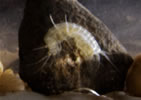Outside the cave there are plenty of green plants growing in the sunlight, and feeding on these are herbivores, that are eaten by carnivores; when any of these die they are consumed by detritivores or decomposed by micro-organisms. All these lead to a large and complicated food web.
Inside the cave the lack of green plants results in the absence of a big chunk of this food web. Micro-organisms in the cave have no sunlight to use as an energy source and use different metabolic pathways – these organisms are crucial for the basis of the food chains in caves.
The creatures found in caves can be classified according to how much of their life cycle they spend in the cave and how dependant they are on the cave environment.
Troglophile: can successfully complete its life cycle both in and out of the cave environment.
Troglobite: cannot complete life cycle outside of the cave environment. These have morphological adaptations to the cave environment e.g. blind, longer legs, lower metabolic rate.
Cavernicole: a more general term for a creature that lives in a caves and can complete its life cycle there, but may also live in other dark habitats e.g. soil, under stones, bark.
Creatures that have spent generations in the dark show genetic modifications compared with the relatives on the surface. This may be due to mutations that occur naturally such as eye defects; outside the creature would be at a disadvantage but in the dark cave environment it makes no difference. Mutations that involve lack of pigment for camouflage would similarly not be a handicap for the cave dweller. Natural selection will mean any mutations that are useful such as longer antennae or lower metabolic rate may increase in the cave dweller, but it will not preserve characteristics that are important outside but of no use in the cave. Eyes are useless and so become vestigial or absent. Touch also becomes more important so some have longer legs and feelers than their outside equivalents. Conserving energy is important when food is scarce and many organisms have a lower metabolic rate that in some cases leads to a long life expectancy. Many lose their camouflage pigments and are white, even trout lighten in colour as no camouflage is needed (although this is temporary unlike the true troglobites).
As many of our troglobites have only been underground since the last Ice Age they have not had time to evolve some of the bizarre adaptations seen abroad, where cave life has been unaffected by such catastrophes for much longer.
Each organism has a preferred habitat where it prefers to live - if you are looking for a specific creature find out about its habits to increase your chances of success.
The creatures are used to the very high humidity and many do not bat an eyelid (if they have one) at being covered in water during a flood, they just sit it out in a crevice and wait for the water to drop.
|
Mite with troglomorphic adaptations, Goyden Pot |
|

